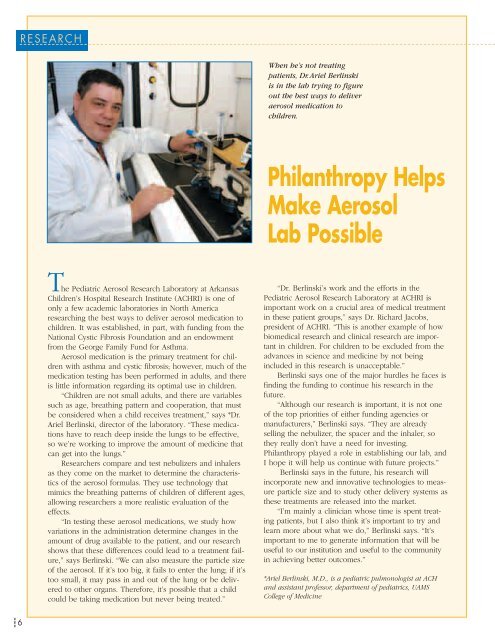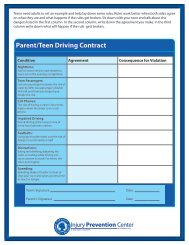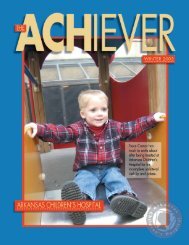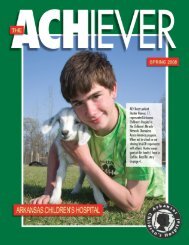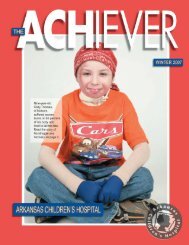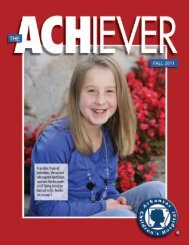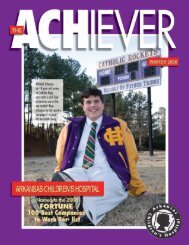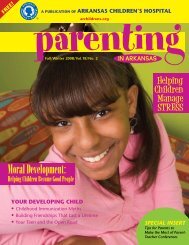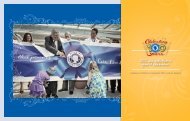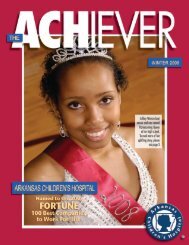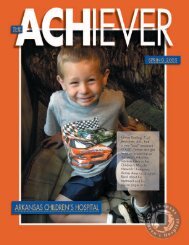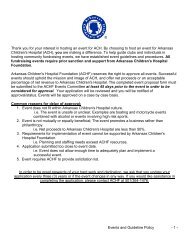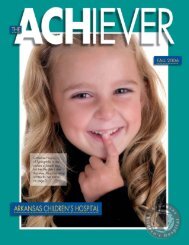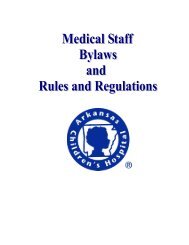Spring 2006 - Arkansas Children's Hospital
Spring 2006 - Arkansas Children's Hospital
Spring 2006 - Arkansas Children's Hospital
Create successful ePaper yourself
Turn your PDF publications into a flip-book with our unique Google optimized e-Paper software.
RESEARCH<br />
When he’s not treating<br />
patients, Dr.Ariel Berlinski<br />
is in the lab trying to figure<br />
out the best ways to deliver<br />
aerosol medication to<br />
children.<br />
Philanthropy Helps<br />
Make Aerosol<br />
Lab Possible<br />
The Pediatric Aerosol Research Laboratory at <strong>Arkansas</strong><br />
Children’s <strong>Hospital</strong> Research Institute (ACHRI) is one of<br />
only a few academic laboratories in North America<br />
researching the best ways to deliver aerosol medication to<br />
children. It was established, in part, with funding from the<br />
National Cystic Fibrosis Foundation and an endowment<br />
from the George Family Fund for Asthma.<br />
Aerosol medication is the primary treatment for children<br />
with asthma and cystic fibrosis; however, much of the<br />
medication testing has been performed in adults, and there<br />
is little information regarding its optimal use in children.<br />
“Children are not small adults, and there are variables<br />
such as age, breathing pattern and cooperation, that must<br />
be considered when a child receives treatment,” says *Dr.<br />
Ariel Berlinski, director of the laboratory. “These medications<br />
have to reach deep inside the lungs to be effective,<br />
so we’re working to improve the amount of medicine that<br />
can get into the lungs.”<br />
Researchers compare and test nebulizers and inhalers<br />
as they come on the market to determine the characteristics<br />
of the aerosol formulas. They use technology that<br />
mimics the breathing patterns of children of different ages,<br />
allowing researchers a more realistic evaluation of the<br />
effects.<br />
“In testing these aerosol medications, we study how<br />
variations in the administration determine changes in the<br />
amount of drug available to the patient, and our research<br />
shows that these differences could lead to a treatment failure,”<br />
says Berlinski. “We can also measure the particle size<br />
of the aerosol. If it’s too big, it fails to enter the lung; if it’s<br />
too small, it may pass in and out of the lung or be delivered<br />
to other organs. Therefore, it’s possible that a child<br />
could be taking medication but never being treated.”<br />
“Dr. Berlinski’s work and the efforts in the<br />
Pediatric Aerosol Research Laboratory at ACHRI is<br />
important work on a crucial area of medical treatment<br />
in these patient groups,” says Dr. Richard Jacobs,<br />
president of ACHRI. “This is another example of how<br />
biomedical research and clinical research are important<br />
in children. For children to be excluded from the<br />
advances in science and medicine by not being<br />
included in this research is unacceptable.”<br />
Berlinski says one of the major hurdles he faces is<br />
finding the funding to continue his research in the<br />
future.<br />
“Although our research is important, it is not one<br />
of the top priorities of either funding agencies or<br />
manufacturers,” Berlinski says. “They are already<br />
selling the nebulizer, the spacer and the inhaler, so<br />
they really don’t have a need for investing.<br />
Philanthropy played a role in establishing our lab, and<br />
I hope it will help us continue with future projects.”<br />
Berlinski says in the future, his research will<br />
incorporate new and innovative technologies to measure<br />
particle size and to study other delivery systems as<br />
these treatments are released into the market.<br />
“I’m mainly a clinician whose time is spent treating<br />
patients, but I also think it’s important to try and<br />
learn more about what we do,” Berlinski says. “It’s<br />
important to me to generate information that will be<br />
useful to our institution and useful to the community<br />
in achieving better outcomes.”<br />
*Ariel Berlinski, M.D., is a pediatric pulmonologist at ACH<br />
and assistant professor, department of pediatrics, UAMS<br />
College of Medicine<br />
6


